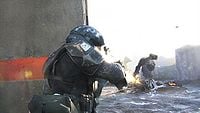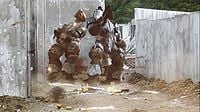Halo film
From Halopedia, the Halo wiki
- "If we ever make a Halo movie, who would you want to write it?" I asked Marty as we exited the theater, "I bet that Garland guy would be all over the Flood."
- — Joseph Staten, after watching 28 Days Later.[1]
The Halo film, officially confirmed in 2005,[2] was a film project in development until its ultimate cancellation in 2006.[3] The film, intended to be produced by Peter Jackson and Fran Walsh and directed by Neill Blomkamp was postponed indefinitely when funding studios 20th Century Fox and Universal Pictures pulled out due to monetary concerns.[4]
When plans for the film eventually fell through, Jackson and Blomkamp instead started production on District 9. Many elements from the cancelled Halo film were re-used or adapted for District 9, including the basic Warthog and Pod infector designs.
Development[edit]
Early origins[edit]
Discussions for a potential Halo film began in early 2002, shortly after the release of Halo: Combat Evolved and in the early preproduction stages of Halo 2. At this time, Hollywood began getting in contact with Bungie staff, surprising the development team with just how far their game's success had reached. Ultimately, these early talks didn't amount to much, as film production for game adaptations at the time was expected to see Bungie have almost nothing to do with the film, with creative control entirely ceded to the filming crew. As such, Pete Parsons urged Joseph Staten to put the film on the backseat, as any time spent on a film project would be time taken away from developing Halo 2 - a production which would soon become an infamous development hell.[1]
Toward the end of Halo 2's development, Parsons introduced Staten to Peter Schlessel (the former president of Columbia Pictures) to discuss a Halo film, though Schlessel was dubious about the idea. Instead, Schlessel urged Bungie to finance a script themselves, and provided a shortlist of writers for consideration - intending for Bungie to get their script together and then pitch it to Hollywood to be picked up. Staten and Martin O'Donnell had seen 28 Days Later a few months prior during a trip to Los Angeles to record Halo 2 voice dialogue, and thus were excited to see the film's writer, Alex Garland, on Schlesser's list - having previously speculated that Garland would be perfect for writing a story with the Flood. A phone call with Garland to discuss potential high-level ideas for a film saw Garland offer to visit the Bungie offices in Seattle, and work began in earnest on creating a script for a Halo film.[1] In February 2005, Creative Artists Agency confirmed that Microsoft had completed a million dollar deal to sign Alex Garland to write the Halo screenplay to be offered around to studios.[5]
Following the release of Halo 2, Joseph Staten took a backseat on the Halo game development to recover from the stress the project had put him through. At this time, around 2005, he began to work with Ensemble Studios on their upcoming Halo MMO and Halo Wars projects, alongside writing Halo: Contact Harvest and becoming the general franchise manager for Halo's extended universe. This role saw Staten head up on the new Halo movie project - which saw Staten take a minimal role on Halo 3 for most of the game's development.[6]
Collaboration with Peter Jackson[edit]
The Halo film was born of a collaboration between Bungie and WingNut Interactive, a studio founded by Peter Jackson who expressed interest in creating a Halo game. At the time of Bungie becoming independent from Microsoft in 2007, a contract was agreed upon in which Bungie would provide three more Halo games, in return for their independence - these three games were Halo 3, a mainline sequel which eventually turned into Halo: Reach and Halo: Chronicles - which would be produced alongside Peter Jackson and WingNut. Jackson visited Bungie's offices in 2005 to speak with Staten and Paul Bertone, with the rest of the team focused on what the successor to Halo 3 was going to be. Later on, Staten and Bertone visited Jackson in New Zealand to plan out the Chronicles prototype - during which discussions the ideas of the Halo film circulated more.[6]
Garland's screenplay was completed later in the year, and on June 6 a stunt was performed in which a series of actors dressed as Master Chief were driven to the various studios in Hollywood with a copy of the Halo script and terms for the deal. This was done by Microsoft, new to the film industry, in an attempt to dazzle the Hollywood executives - which succeeded in making headlines.[7] Ultimately, these terms were seen as extremely heavy-handed, and showed how unfamiliar Microsoft was in dealing with the medium of film.[8]
For the rights to a film production, Microsoft expected to be paid a $10 million fee as well as the studio's agreement to adhere to guidelines set by the game's developers.[7] Microsoft also wanted the studio to seek approval over the director and cast. In addition, Microsoft sought full merchandising rights for itself, a minimum $75 million budget, and company representatives' full access to the film's rough cuts in Los Angeles. Most potential studios - namely Paramount, DreamWorks, Sony, and Warner Bros. - did not want to cede creative rights to the film and passed over the project.[9]
Ultimately, 20th Century Fox and Universal Studios entered negotiations with Microsoft to divide the distribution rights to Halo. The original $10 million deal was reduced based on the studios' negative response to the exorbitant price tag. All negotiating parties eventually agreed upon a deal to produce the Halo film; it was decided that Universal would distribute domestically, and take sales from the U.S. box office, while Fox would take the international distribution - with both co-financing the film. The studios agreed to give Microsoft $5 million to option the film, and 10% of grosses.[4]
On August 22, 2005, the deal was announced to be finalized, with summer 2007 as the target release date.[10] On October 4, Bungie announced their partnership with Peter Jackson, alongside Universal Studios' producers Mary Parent and Scott Stuber.[11] It was later revealed that the film would have been shot in Wellington, New Zealand.[2]
In July 2006, author D. B. Weiss announced that he was working on his second draft of the new script for Halo, which contained elements of the project's original screenplay by Alex Garland.[12] Other screenwriters, namely Scott Frank and Josh Olson were also attached to the rewriting of Garland's script.
A few weeks after Bungie's meeting with Jackson in New Zealand, Guillermo del Toro was signed on to direct with Jackson producing, though del Toro's involvement ultimately fell through and he was replaced by Neill Blomkamp.[6] An interview with del Toro conducted in August 2005 mentioned that the director was excited for Halo due to finding the series' setting and protagonist of the Master Chief interesting in a way that other video game films weren't - though also added that he was early in the pre-production stages for Hellboy II, and thus considered it his first priority, adding that if the option were still available once Hellboy had finished he would still be open to make Halo.[13]
Blomkamp's involvement was announced in August 2006, with the caveat that he would direct for a smaller fee - despite Microsoft wanting Jackson to direct. Ultimately, Jackson's more direct involvement would cost much more money - with Jackson's fees already running into several millions of dollars. During this time, Universal funded $12 million for the film's development - a portion of which was spent by del Toro during his tenure with concept art produced. This concept art was stated by Blomkamp to be something he was confident Bungie were happy with, though Microsoft became worried the material was too unconventional for the summer blockbuster they wanted. Ultimately, del Toro went on to make Hellboy II: The Golden Army and the rest of the money was spent on the new screenwriters and a watch for Peter Jackson.[8]
Cancellation[edit]
In January 2006, Universal's chairman Stacey Snider stepped down from her role, though Universal agreed to honour their existing contract on the film. This involved Peter Jackson taking a significant chunk of the budget as his pay, with Microsoft promised another 10% of the payout. Later in September 2006, Fox co-chairmen Tom Rothman Jim Gianopoulos were stated to have been worried about the glacial pace of development and spiralling costs - with no completed script to show for it. Fox ultimately called for a meeting to express these concerns, with rumours saying that News Corp. CEO Peter Chernin called upon Microsoft CEO Steve Ballmer to remove Universal from the project entirely.[14]
In October 2006, Universal were nearing another payment, prompting Rothman and Gianopoulos to insist that the first-dollar deals awarded to Jackson, Fran and Schlessel all be revoked - or Fox would walk.[14] Jackson consulted with Microsoft, his co-producers, and Blomkamp, but ultimately refused the deal. Universal and Fox subsequently removed themselves from the deal. Blomkamp and Jackson have both cited money and control as their main reasons to abandon production.[15] In response to these events, a representative of Jackson and Walsh stated;
| “ | Universal, on behalf of both studios, asked for a meeting with the filmmakers just prior to the due date of a significant payment. Basically, they said that in order to move forward with the film, the filmmakers had to significantly reduce [the percentage of profits they would receive from the film]. They waited until the last minute to have this conversation. Peter and Fran, after speaking with their producing partners and with Microsoft and Bungie, respectfully declined.[16] | ” |
Contrary to claims that Microsoft were seeking other distributors for the film, WingNut Films stated;
| “ | As was previously confirmed, we deeply regret that both Universal and Fox did not choose to move forward with financing the Halo film under the original terms of the agreement. At this time Peter Jackson and Fran Walsh, along with their partner, Microsoft, have mutually agreed to postpone making a feature film based on the Halo video game universe until we can fulfill the promise we made to millions of Halo fans throughout the world that we would settle for no less than bringing a first class film to the big screen. We are fully supportive of director Neill Blomkamp's vision of the film. Neill is a tremendously gifted filmmaker and his preliminary work on Halo is truly awe-inspiring. While it will undoubtedly take a little longer for Halo to reach the big screen, we are confident that the final feature film will be well worth the wait.[3] | ” |
Blomkamp later elaborated on this, stating that considerable studio friction drove the project apart. Blomkamp felt that the production studios, especially Tom Rothman (co-chairman of Fox), did not trust his creative vision, and that as someone in the target demographic for Halo he was much more suited to make creative decisions than them. His vision for a "gritty, post-cyberpunk aesthetic" clashed with the studios' wish for a more traditional summer blockbuster - further adding that he believed "Rothman hated me", and would have fired him if he had the authority to. Similar creative tensions manifested with Microsoft, who were also clashing with the two film production studios over monetary issues - though he added that he believed Bungie were happy with the film's direction.[8]
Fox pulling out of the project Universal had already poured $12 million caused Universal to threaten Fox with legal action, though the two ultimately settled out of court - though anonymous sources later reported that Universal lost nearly all of its investment in the process.[14] Despite this obstacle in production, Ken Kamins - a representative of Jackson - confirmed in an interview on October 29, 2007 that the Halo film was still in pre-production. According to Kamins, Blomkamp had not been dropped - in spite of his earlier statements.[17]
On July 24, 2009, Blomkamp denied that his upcoming District 9 would be a showcase for his Halo film intentions, and confirmed he was no longer involved.[18] The director later revealed in August that the film's budget would have been $120 million.[19]
Story and script[edit]
Garland's script[edit]
In a 2012 interview with IGN, Garland described his screenplay for Halo as essentially an adaptation of the story of Halo: Combat Evolved, with elements of Halo 2's ending. Garland described his vision as one mostly informed by the games themselves, and also akin to a less satirical take on Starship Troopers.[20] This has also been supported by Paul Russel.[21]
Del Toro's script[edit]
In 2020, Paul Russel recalled a mention by Joseph Staten of a script pitched to him by Guillermo del Toro. In this script, del Toro supposedly envisioned that Master Chief would have a twin brother who would turn evil and defect to the Flood (or possibly become infected) - with the two facing off at the film's climax.[22][23]
Beattie's script[edit]
During the writer's strike in 2007, Stuart Beattie - a screenwriter known for his work on G.I. Joe: The Rise of Cobra - took it upon himself to write a speculative script for a Halo film treatment, unrelated to the script penned by Garland intended for use in the now-dead film project. Unlike Garland's script, Beattie's screenplay is based upon Halo: The Fall of Reach, a novel written by Eric Nylund. The script was compared to Jaws, with the Covenant not being seen for the first half of the film to build up their threat.[24] Beattie was quoted as saying; "It's not something I can direct right now, because it's a big $100 million-plus film... [but] I would just love to see a Halo movie up there on screen. It's magnificent."[25][26][27] By October 2008, Beattie's script was projected to have a 2009 release.[28]
Art and props[edit]
- "Um. The dudes at WETA made a Warthog. I don’t mean that they made a big plastic thing that looks like a Warthog. I mean they built a fully-functioning, four-wheel steering, powerful, off-road vehicle with a machine gun on the back. At the correct scale. If you live near Wellington, New Zealand, you might even see some crazy machine-shop dude from WETA fishtailing around your base, ahem, I mean neighborhood."
- — Frank O'Connor[29]
Preproduction for the film was primarily carried out by WETA Workshop, known for their work on Lord of the Rings. WETA worked for around six months to create a number of physical props for the film and the subsequent Halo: Landfall short film, based on equipment designs from across Halo: Combat Evolved, Halo 2 and the then-upcoming Halo 3.[30] These include BR55 battle rifles, SRS99D-S2 AM sniper rifles, ODST armor, Marine armor, a Laser designator, an M41 SPNKR rocket launcher and perhaps most notably, a 1:1 fully-drivable replica of the M12 Warthog, complete with a fully-rotating M41 Vulcan turret.[29] A number of images of these props were posted by Blomkamp on his Instagram page in 2014, though many of the images have since been deleted. They include radical redesigns of the Covenant species, with total rehauls given to the Elite and Prophet characters.[31]
Concept art for the film was produced, including by artists Eddie Smith and Aaron Beck.[32][33] Smith was responsible for a painting done in early 2005, showcasing the Master Chief having his MJOLNIR Mark V armor inspected by some technicians, while Beck would post some of his concept work on Instagram in 2021 - depicting concept art for an Elite redesign - before later deleting the post.[34]
Guillermo del Toro also did a concept design for the Master Chief during his brief time attached to the film. He described the process in the DVD commentary for Hellboy 2, in which he described Master Chief's helmet as being "sleek and self concealed". It is likely that this direction, along with the unconventional Elite and Prophet designs mentioned prior, were those concepts mentioned as being too risky for Microsoft - who were wanting more conventional designs for a summer action blockbuster.[8]
Concept art created for the film by Eddie Smith for Del Toro's film.[35]
Exploratory concept art by Eddie Smith for Del Toro's film.[36]
A physical prop of an Elite, posted by Neill Blomkamp on Instagram.[37]
A physical prop of a Prophet, posted by Neill Blomkamp on Instagram.[38]
Nathan Fillion holding the sniper rifle during his visit to Bungie for his work on Halo 3: ODST.
At the end of the film projects, the various physical props made for the production were packed up into storage crates. A few of these props ended up being sent to the Bungie offices including at least one battle rifle and the sniper rifle. During a studio move in 2009, Bungie employees carrying these prop firearms were mistaken by people in the street for gunmen carrying AK-47s, and Kirkland police were called to investigate.[39] Bungie later sold off their battle rifle in 2011 during a charity auction for Child's Play, wherein the prop was sold for $4,550.[40]
Several of the battle rifle props are still kept by Neill Blomkamp in his office, as of 2019.[41]
Concept art for Stuart Beattie's iteration of the Halo film would later leak online on the review site LatinoReview - the same site which had originally leaked details about Garland's script. The five images, concepted by Kasra Farahani, were done as part of a pitch prepared to present to Microsoft some time around late 2008. However, these concepts were essentially fan art done for an independent pitch - not officially comissioned artwork by Microsoft. The first depicts the SPARTAN-IIs deploying into space in the middle of a space battle involving what appears to be UNSC Pillar of Autumn, led by Master Chief. This first image possibly coincides with the mission to Gamma Station during the space battle over Reach, late in the book.[42] The second image features the Master Chief and the other Spartan cadets training on Reach.[43]
The third and fourth concepts deal with the Spartans' defense (and ultimate defeat) of Reach.[44] The fourth image is said to depict Master Chief fighting to get Cortana off Reach, with Foehammer's Pelican coming to save him.[45] The fifth concept showcases the Pillar of Autumn engaging in a space Battle over Installation 04.[46]
Concept of Spartans (with Master Chief in the middle) deploying in an extra-vehicular activity.
Concept art of SPARTAN-II training.
Legacy[edit]
The collaboration of many creators involved with the Halo film would ultimately go on to inform several major films released in the ensuing years. Guillermo del Toro was later slated to direct the Hobbit films produced by Peter Jackson, though he ultimately ended up stepping away from the project to work on Pacific Rim alongside Mary Parent - with Jackson going on to direct the Hobbit trilogy.[47]
Halo TV and webseries[edit]
Although the Halo film was ultimately dead, Microsoft's hopes for a Halo live action feature were not. On August 10, 2009, Steven Spielberg was reported to have been "blown away" by Beattie's screenplay, and was in "active negotiations" to produce a future Halo feature.[48] These discussions, involving Spielberg and DreamWorks, were reported to focus on adapting the Halo novels, rather than the games, to avoid the mess of the previous film. This would additionally offset any issues with the lingering hostilities from the previous attempt, with DreamWorks worried that Universal might try and elicit payment for the $12 million they had lost in their preproduction.[14]
Spielberg was ultimately later involved with discussions with Microsoft, and would later go on to produce the Halo television series. The failures of the Halo film were learnt from heavily in the production of the TV show, with Microsoft dialing back their need for total adherence to strict canon and creative control. This ultimately led to the creation of the "Silver Timeline" alternate continuity, in which the TV show is set.[49]
The following day, Microsoft responded to the prior report by Spielberg, claiming it was "glad" of the enthusiasm surrounding a Halo feature, although the project still remained on hold.[50] On October 6, 2009, Frank O'Connor confirmed that Microsoft was still "being very careful to pick the right time and the right partner" with regards to a new Halo feature.[51] In 2010, O'Connor stated that Microsoft will make a film "when the time is right", and that it would be a standalone story rather than "a verbatim retelling of the game".[52][53] O' Connor also hinted at a future live action miniseries, which would later be revealed as Halo 4: Forward Unto Dawn. A second webseries, produced by Ridley Scott titled Halo: Nightfall, was released in 2014.
Halo: Landfall and District 9[edit]

- Main article: Halo: Landfall
Although the Halo film was cancelled, Jackson, Blomkamp and WETA Workshop had spent months on preproduction for the Halo film, and built numerous props including ODST armor, sniper rifles, battle rifles and Marine armor - among others. As such, this effort was not wasted, and Blomkamp instead directed a series of shorts titled Halo: Landfall. The Landfall project comprised of three short videos titled Arms Race, Combat and Last One Standing, released over Xbox LIVE in parts and eventually compiled under the Landfall name. The shorts depict an Orbital Drop Shock Trooper fireteam during the Battle for Earth concurrent with the opening of Halo 3, and employ many of the props developed by WETA for the film project.[6] While filming Landfall, Blomkamp suffered an injury in the Warthog that tore off part of his right ear, requiring reconstructive surgery.[55]
Following the end of the Landfall project, Blomkamp and Jackson continued their partnership to create the film District 9. The film utilises many of the ideas and concepts generated for the Halo film and Halo: Chronicles, including alien creatures heavily derived from the Halo film's concepts for Flood infection forms and Elites, and the ideas of a human transforming into a new alien form of life. On April 10, 2013, Blomkamp mentioned that he was still interested in directing for Halo, but only if he was given more creative freedom.[56] In July 2017, Blomkamp affirmed this statement, adding that he is still open to doing a movie but Microsoft has not approached him. O'Connor subsequently stated that Microsoft would "be delighted to work with [Blomkamp] again one day.[57]
Gallery[edit]
Two Brutes attacking with spikers in Last One Standing.
A poster for Halo 4: Forward Unto Dawn, a non-theatrical Halo film.
Sources[edit]
- ^ a b c Bungie.net, The Great (Hollywood) Journey (Retrieved on Feb 7, 2021) [archive]
- ^ a b BBC News, Halo game set for silver screen (Retrieved on Mar 21, 2022) [archive]
- ^ a b IGN, Halo Holding (Retrieved on Mar 21, 2022) [archive]
- ^ a b IndieWire, "It Was A Clusterfuck From Day One": 5 Things About Neill Blomkamp's Failed 'Halo' Movie (Retrieved on Jul 29, 2015) [archive]
- ^ Variety, Halo, Hollywood (Retrieved on Mar 20, 2022) [archive]
- ^ a b c d VICE, The Complete, Untold Story of Halo (Retrieved on Mar 21, 2022) [archive]
- ^ a b IGN, Halo Movie Script Delivered (Retrieved on Jun 11, 2005) [archive]
- ^ a b c d Wired, Why the Halo Movie Failed to Launch (Retrieved on Mar 20, 2022) [archive]
- ^ E! Online, Hollywood's Halo Effect (Retrieved on Oct 1, 2007) [archive]
- ^ Variety, Halo makes a date (Retrieved on Jan 7, 2007) [archive]
- ^ Bungie.net, 10,000 Pound Gorilla (Retrieved on Feb 5, 2021) [archive]
- ^ GameSetWatch, GameSetInterview: Halo Screenwriter DB Weiss (Retrieved on Aug 28, 2021) [archive]
- ^ Empire, Del Toro Caught Between Halo And Hellboy (Retrieved on Mar 21, 2022) [archive]
- ^ a b c d Vulture, The New Halo Game Is a Hit — So What’s the Status of the Halo Movie? (Retrieved on Mar 21, 2022) [archive]
- ^ Huffington Post, Best Films Never Made: Neill Blomkamp's Halo (Retrieved on Mar 20, 2022) [archive]
- ^ IGN, Halo Movie Dumped (Retrieved on Mar 20, 2022) [archive]
- ^ CVG, MS "already in talks" to continue Halo film (Retrieved on Oct 17, 2012) [archive]
- ^ Slashfilm, Confirmed: Director Neill Blomkamp Would Probably Not Do a Halo Film, Even If Offered One (Retrieved on Mar 20, 2022) [archive]
- ^ UGO, District 9 - Neill Blomkamp Interview (Retrieved on Jul 7, 2010) [archive]
- ^ IGN, Alex Garland Discusses His Halo Movie (Retrieved on Mar 21, 2022) [archive]
- ^ Twitter, Paul Russel (@docabominable): "The concept art was fun. Would’ve looked very different than the games. If they were using Garland’s script it would’ve been a straight retelling of the first game." (Retrieved on Dec 13, 2022) [archive]
- ^ YouTube - IGN, Halo: Combat Evolved Devs React to Speedrun (Marty O'Donnell, Marcus Lehto): 58:54
- ^ IGN, Halo Movie: Guillermo del Toro Apparently Wanted Master Chief to Have an Evil Twin (Retrieved on Mar 30, 2022) [archive]
- ^ SlashFilm, G.I. Joe Screenwriter Stuart Beattie Has Written Halo Spec Script (Retrieved on Mar 21, 2022) [archive]
- ^ LatinoReview, Exclusive: Halo Movie has Reach! (Retrieved on Apr 2, 2008) [archive]
- ^ FirstShowing, Stuart Beattie Wrote His Own Halo Script to Sell! (Retrieved on Mar 20, 2022) [archive]
- ^ Blastr, Why Stuart Beattie believes his Halo film will work: Deadlink (Retrieved on Jul 30, 2009)
- ^ ScreenRant, Is There Any Progress On The Halo: Fall Of Reach Movie? (Retrieved on Mar 21, 2022) [archive]
- ^ a b Bungie.net, Bungie Weekly Update: 7/20/07 (Retrieved on Feb 7, 2021) [archive]
- ^ Rotten Tomatoes, Neill Blomkamp talks District 9 - RT Interview (Retrieved on Feb 3, 2010) [archive]
- ^ Health Regen, Neill Blomkamp’s Failed Halo Movie Props (Retrieved on Jan 6, 2015) [archive]
- ^ Visualatrium, llustrations: The artwork referred to as "Awakening" on Eddie Smith's portfolio website (Retrieved on Mar 21, 2022) [archive]
- ^ Artstation, The Chief Awakens: "This is one of the first paintings I did back on 2005 for a possible Halo Film when I worked at Bungie." - Eddie Smith (Retrieved on Mar 21, 2022) [archive]
- ^ Twitter, Saber One (@thenoblesaber): Original source defunct "Aaron Beck just posted this on Instagram. Possible concept art of Elites for the #Halo movie by Neill Blomkamp? Looks pretty similar to the maquette." (Retrieved on Mar 21, 2022) [archive]
- ^ Instagram, Eddie Smith: "THE CHIEF AWAKENS
I painted this in 2004 while working at Bungie Studios. At one point, Guillermo Del Toro wanted to make a Halo film that he planned to pitch to several studios. This painting was the first in a series of pitch artwork that was done for it. I envisioned Master Chief's suit as a wearable spacecraft, since that’s what real life space suits are, pretty much. And like NASA astronauts, a team of engineers would assemble the suit around him. This painting was also used by 343 INDUSTRIES for HALO 5." (Retrieved on Jan 30, 2023) [archive] - ^ Instagram, Eddie Smith: "INSURRECTION
This was the second mood piece (after THE CHIEF AWAKENS, previous post), I did in a small series, again for Guillermo Del Toro and his unrealized Halo Film. Here, an O.D.ST commando restrains an upset Master Chief, chewing out a Lieutenant for his negligence leading to a soldier's death. The dead Spartan in question can be seen to the far left being carried off by flight crew officers." (Retrieved on Jan 30, 2023) [archive] - ^ Instagram, @Neill Blomkamp: "#halo elite from 06 #weta" (Retrieved on May 4, 2014)
- ^ Instagram, @Neill Blomkamp: "#halo #prophet over my desk from failed film" (Retrieved on Nov 11, 2014)
- ^ Kotaku, Police Swarm To Bungie On Weapons Call During Kotaku Visit (Retrieved on Mar 21, 2022) [archive]
- ^ eBay, Bungie: Original Halo Weta UNSC Battle Rifle (Retrieved on Jul 1, 2011) [archive]
- ^ Twitter, Neill Blomkamp (@neillblomkamp): "ahha. i love that [sniper rifle] prop. whoever designed that for HALO originally know of the SA NTW-20. I still have some of the Battle Rifles in my office from the Landfall shoot" (Retrieved on Mar 21, 2022) [archive]
- ^ LatinoReview, Exclusive: Halo Fall Of Reach Concept Art! (Retrieved on Aug 27, 2008) [archive]
- ^ LatinoReview, Exclusive: 2nd Halo Fall Of Reach Concept Art! (Retrieved on Aug 27, 2008) [archive]
- ^ LatinoReview, Exclusive: 3rd Halo Fall Of Reach Concept Art! (Retrieved on Aug 28, 2008) [archive]
- ^ LatinoReview, Exclusive: 4th Halo Fall Of Reach Concept Art! (Retrieved on Aug 28, 2008) [archive]
- ^ LatinoReview, Exclusive: 5th Halo Fall Of Reach Concept Art! (Retrieved on Aug 28, 2008) [archive]
- ^ HN Entertainment, An Extensive Look at The ‘Halo’ Movie That Never Happened (Retrieved on Mar 21, 2022) [archive]
- ^ Kotaku, Steven Spielberg To Produce Halo Movie? (Retrieved on Mar 20, 2022) [archive]
- ^ Variety, More Than $90 Million and 265 Script Drafts Later, 'Halo' Is Finally a TV Show (Retrieved on Mar 20, 2022) [archive]
- ^ Kotaku, Microsoft: Halo Movie Still "On Hold" (Retrieved on Mar 20, 2022) [archive]
- ^ USA Today, Video game 'Halo' spins off books, action figures and more (Retrieved on Mar 21, 2022) [archive]
- ^ IGN, Halo Movie Will Still Happen (Retrieved on Mar 21, 2022) [archive]
- ^ Variety, "Halo": the care and feeding of a franchise (Retrieved on Mar 21, 2022) [archive]
- ^ Instagram, @Neill Blomkamp: "#halo #odst and unused #district9 exo" (Retrieved on Jun 6, 2014)
- ^ PC Gamer, Neill Blomkamp ripped his ear off in a Warthog while filming Halo (Retrieved on Mar 21, 2022) [archive]
- ^ Joystiq, Neill Blomkamp would still like to do that Halo movie (Retrieved on Apr 12, 2022) [archive]
- ^ GameSpot, After Halo Movie Fell Apart, Director Still Wants Another Shot (Retrieved on Mar 21, 2022) [archive]
See also[edit]
- Garland's Halo script - Halopedia backup
| ||||||||||||||


![Concept art created for the film by Eddie Smith for Del Toro's film.[35]](https://halo.wiki.gallery/images/thumb/9/99/HaloMovie_Awakening_Concept.jpg/136px-HaloMovie_Awakening_Concept.jpg)
![Exploratory concept art by Eddie Smith for Del Toro's film.[36]](https://halo.wiki.gallery/images/thumb/f/f3/HaloMovie_Insurrection_Concept.jpg/200px-HaloMovie_Insurrection_Concept.jpg)

![A physical prop of an Elite, posted by Neill Blomkamp on Instagram.[37]](https://halo.wiki.gallery/images/thumb/3/37/HaloMovie_Elite_Prop.jpg/120px-HaloMovie_Elite_Prop.jpg)
![A physical prop of a Prophet, posted by Neill Blomkamp on Instagram.[38]](https://halo.wiki.gallery/images/thumb/b/bb/HaloMovie_Prophet_Prop.jpg/120px-HaloMovie_Prophet_Prop.jpg)

















